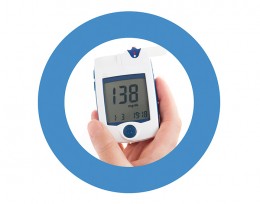 Some 86 million people have prediabetes, and nine out of 10 of them are undiagnosed. Without weight loss and moderate physical activity, 15 to 30 percent of those 86 million will develop type 2 diabetes within five years, according to the Centers for Disease Control and Prevention (CDC).
Some 86 million people have prediabetes, and nine out of 10 of them are undiagnosed. Without weight loss and moderate physical activity, 15 to 30 percent of those 86 million will develop type 2 diabetes within five years, according to the Centers for Disease Control and Prevention (CDC).
More than 12 percent of all residents in Montgomery County have diabetes, which is higher than both the state (11 percent) and national (9 percent) rates, according to Diabetes Dayton, a local, independent diabetes agency serving the Dayton area.
To help raise awareness of diabetes, faculty and students from the Wright State University Boonshoft School of Medicine Master of Public Health Program are working with Public Health – Dayton & Montgomery County (PHDMC), Diabetes Dayton and the YMCA of Greater Dayton to encourage residents to get checked for diabetes on Diabetes Alert Day, which is Tuesday, March 22.
The students will be at Dayton-area Kroger stores promoting prediabetes awareness, offering on-site risk assessment and referring people to the three local Diabetes Prevention Programs in Montgomery County. Diabetes Dayton, PHDMC and the YMCA of Greater Dayton are part of the national Diabetes Prevention Program and are recognized by the CDC.
Nikki L. Rogers, Ph.D., assistant professor of community health in the Center for Global Health in the Department of Community Health, and Michael N. Dohn, M.D., associate professor of community health and internal medicine in the Master of Public Health Program, are working with the PHDMC to implement part of a CDC-funded national grant, Communities Preventing Chronic Disease. The CDC provided funding to the Ohio Department of Health, which awarded $1.6 million over four years to PHDMC to prevent obesity, diabetes, heart disease and stroke in Montgomery County. The grant will end in August 2018.
Rogers describes diabetes as a national catastrophe waiting to happen.
“We have an aging population that is increasingly inactive, overweight, obese and at a higher risk of disability and death because of lifestyle factors that they can change,” she said. “This increased rate of people at risk for diabetes has been described as a looming health crisis that will result in more disability, loss of quality of life, medical expenses and deaths due to chronic disease if we can’t stop the disease progression at the prediabetes stage. That’s where the Diabetes Prevention Program comes in.”
Rogers and Dohn are focusing on prediabetes screening, awareness and treatment.
“It is possible to stop the progression from prediabetes to diabetes by following evidence-based programs for creating a healthy lifestyle,” Rogers said. “People who have prediabetes should see it as a wake-up call to start making changes that can have a positive impact on their overall health.”
They have included several Master of Public Health students in the work, including Justin Kelley, a dual-degree medical student who is working toward both his M.D. and Master of Public Health degree. He has worked on creating program resources to help prevent and reduce the burden of diabetes in Montgomery County.
“Prediabetes is a silent threat to public health. Our patients and community are at risk,” said Kelley, a member of the Montgomery County Diabetes Coalition. “Diabetes is scary. But we can prevent or delay the onset of diabetes in individuals with prediabetes, reducing the burden of diabetes.”
For more information about prediabetes and diabetes, visit doihaveprediabetes.org or
diabetesdayton.org.

 Difficult conversations
Difficult conversations  Celebrated Wright State alum serving his community as surgeon
Celebrated Wright State alum serving his community as surgeon  Wright State University Foundation awards Students First Fund grants
Wright State University Foundation awards Students First Fund grants  Cosmic collection
Cosmic collection  Wright State revives student-faculty collaborative writing journal
Wright State revives student-faculty collaborative writing journal 